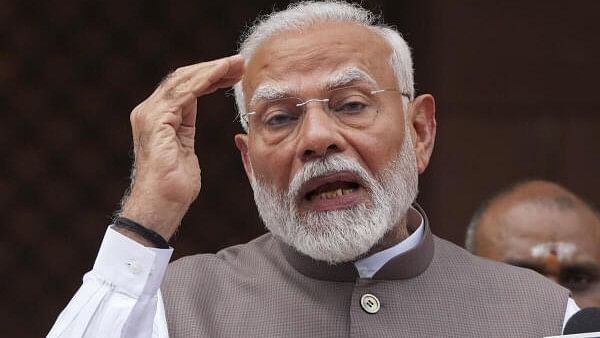
Prime Minister Narendra Modi addresses the media on the first day of the Monsoon session of Parliament, in New Delhi.
Credit: PTI Photo
By Mihir Sharma
Ten years after he was first elected India’s prime minister, Narendra Modi may finally have diagnosed why India’s growth, while better than in many countries, hasn’t taken off the way his supporters expected in 2014. But he still needs to prove he’s willing to do what it takes to fix the problem.
The budget that Finance Minister Nirmala Sitharaman announced earlier this week will serve as the major economic policy roadmap for the year. It wisely focused on three issues: debt, factor markets including land and labor, and jobs. All are drags on growth.
Modi has credibility on the first. His governments have unquestionably been fiscally conservative. Even in this budget, released in an election year when most politicians would have turned on the spending taps, Sitharaman reduced the fiscal deficit target by two-tenths of a percentage point from earlier projections, to 4.9 per cent of GDP.
Deficits have been high enough and growth low enough for long enough that Indian public debt has reached worrisome proportions, topping 80 per cent of GDP earlier this year. Nevertheless, when Sitharaman promises “central government debt will be on a declining path as a percentage of GDP,” most investors will believe her.
That’s emphatically not the case for the government’s other pledges. Even if debt is lowered, thereby making more funds available for the private sector, investors won’t put that money to work until they see the sort of efficient and predictable business environment that makes it easy to raise credit, build companies, and hire people.
They also need markets: either enough consumers in the country with wages high enough to create demand, or thriving export markets. The last decade has instead seen underwhelming jobs growth and stagnant wages. Domestic consumption has stuttered as a result. Meanwhile, tariffs are too high and unpredictable for domestic producers to easily participate in global value chains.
For the first time, Modi’s government has promised to address both problems. The budget pledged a new “economic policy framework” that would guide sweeping reforms, particularly of the factors of production: land, labor, and credit.
This comes as a surprise. Modi had to roll back an earlier attempt to change land acquisition rules in the face of sustained protests. After that, the fundamental reforms that economists champion seemed to be off the table. Sitharaman also promised to spend the next six months reviewing tariffs with an eye to lowering them.
The pledges sound great on paper. If the government follows through — deregulating factor markets, lowering tariff barriers, and spurring domestic demand — Indian growth should indeed take off.
But, while Modi has stored up credibility as a fiscal hawk, he has none left as a reformer. Ten years ago, when he swept India’s right-wing into office alongside hopeful (and fanciful) comparisons to Margaret Thatcher and Ronald Reagan, many observers imagined him to be a classic economic liberal. Had he proposed a similar policy framework in his first budget, economists would have swooned.
Today, expectations are far more muted. Modi has governed as a statist, not a reformer. He has demonstrated a marked preference for publicly run companies and a disdain for independent regulators.
The fact that none of this comes naturally to him can be seen in the budget’s employment policies, which are mostly a rehash of opposition ideas — and not very good ones. Both the “employment-linked incentives” for corporations to hire and subsidies for India’s top 500 companies to take on thousands of interns transfer the job of preparing the workforce for formal employment onto the private sector. They give politicians a reason to meddle in the hiring practices of private companies — the last thing an already sclerotic job market needs.
Modi’s diagnosis of what has gone wrong with India’s growth has come 10 years too late. Few investors will believe his promises of reform. Meanwhile, problems with productivity, regulation and skills have deepened. Modi will have to work even harder to convince investors he’s serious — and there’s little reason to think he will try that hard.
Union Budget 2024 LIVE | Making a record for any Finance Minister, Nirmala Sitharaman presented her 7th consecutive Union Budget on July 23, 2024 under the Modi 3.0 government. This Budget brought tax relief for the middle class, while focusing on jobs through skilling, incentivising employers. Track the latest coverage, live news, in-depth opinions, and analysis only on Deccan Herald. Also follow us on WhatsApp, LinkedIn, X, Facebook, YouTube, and Instagram.